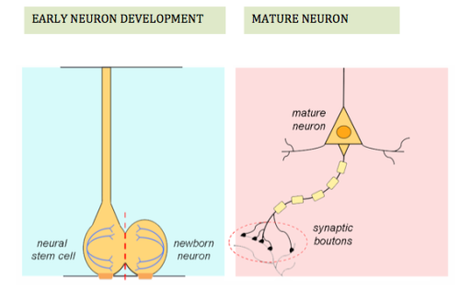By Emily L. Casanova, Ph.D. & Manuel F. Casanova, M.D.
Across many different fields of study, evidence is emerging that autism is a disorder caused by disturbances of early brain development. Over the last decade, autism research has strongly focused on synapse dysfunction, however a recent genetic analysis has revealed that while synapses are probably dysfunctional in autism, much earlier stages of brain development may be just as foundational to the condition.
In humans the production of new neurons continues up into the early part of the third trimester. By comparison, synapses, which are the communicative junctions of neurons , are not established until after birth and continue to be remodeled throughout the lifespan. Current evidence stresses the importance of early brain development in autism risk, however it also raises an important question: Can both early and later brain development be affected in autism? Below is a schematic of the ways that neurons look during development, and then how they look when they are mature.

Our laboratory has focused on the idea that many stages of brain development are affected in most cases of autism. In our most recent publication in Frontiers in Cellular Neuroscience, we report that most of the high-risk gene mutations associated with autism impair not only later synapse development but also earlier stages of neuron production and maturation. This tells us that autism is caused not only by dysfunctional synapses but by dysfunctional neural networks and neurons. This understanding is vital, not only so we can decipher how this heterogeneous condition develops, but also to be able to predict the different ways in which it might be treated or even prevented. In order to design successful treatments, we must know precisely what we’re dealing with.
Determining the ways in which the brain is affected in autism may also help us understand how different types of autism arise, and how these cases may be similar and/or different from typical forms of the condition. For instance, the childhood epilepsy known as Dravet Syndrome (DS) presents with normal or relatively normal cognitive development throughout the first year of life. Yet between ages 1-2 years these children develop seizures often in response to fever or illness. Following seizure onset, approximately 25% of these children also develop symptoms of autism, making DS a well-recognized form of syndromic autism. However, individuals with DS also exhibit brain malformations similar to those seen in typical and syndromic autism. Because these malformations occur very early in brain development, this indicates that DS, and perhaps other forms of regressive autism, have prenatal roots even though symptoms aren’t obvious until 1-2 years of age.
This work stresses the need for a paradigm shift in autism research and a broader understanding of how the brain develops. While it may be simpler to study a single structure or developmental stage, a tunnel-vision approach may not provide us with an accurate understanding of what has occurred to produce the condition we’re investigating. We hope that a broader developmental point of view is a step in the right direction, helping to bring together different branches of research so that their results complement each other rather than confuse the field. Autism, after all, is a puzzle. We need to be looking at all the pieces together.
